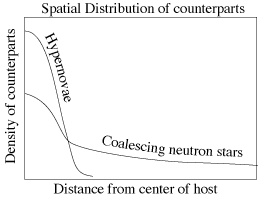Swift Follow-up Observations
Swift will observe hundreds of GRBs per year, producing positions, light curves, and, in most cases, redshift distances. Under our data distribution policy of Everything to Everyone, Immediately, any observer using any instrument can make follow-up observations based on the data as soon as it is ready (within seconds of the GRB for arc-minute positions, minutes for arc-second positions, hours for redshifts). Members of the Swift follow-up team have access to the following instruments, but more observatories are always welcome:
| Follow-Up Teams | ||||||||||
|---|---|---|---|---|---|---|---|---|---|---|
| 1m, 1.3m USNO | 3.5m ARC | 9m SALT | AEOS | |||||||
| ARAGO (TAROT-2) | CTIO | EOS | ESO | |||||||
| FAME | Faulkes | Galileo | HET | |||||||
| HST | INTEGRAL | IRTF | KAIT (0.8m auto) | |||||||
| Keck | KPNO | La Silla | LBT | |||||||
| LIGO | Liverpool Telescope | McDonald | Milagro | |||||||
| Newton Telescopes | NOT La Palma (2.5m) | Okayama Observatory | Paranal | |||||||
| REM | ROTSE | SAAO | SARA Kitt Peak | |||||||
| SIRTF | Super-LOTIS | TAOS | TAROT | |||||||
| Tenerife | VERITAS | VLT | WASP | |||||||
| WIRO | WIYN | |||||||||
The types of follow-up observations made will typically depend on the questions of interest, and on the properties of the GRB measured by Swift. Swift will produce so many GRB measurements that most will not be followed up from the ground, due to the lack of available observing time. After the first few dozen intensively studied GRBs, observing plans probably will concentrate on bursts with specific properties to answer specific questions. Population studies will probably be based on the uniform measurements of positions, spectra, light curves, and distances that Swift provides.
Hubble Deep Field Image, with XRT and UVOT position accuracy shown


The UVOT will precisely locate GRBs to sub-arcsecond accuracy. Leisurely follow-up studies, based on existing surveys or on observations scheduled some time later, can use these positions to determine the relationship between GRBs and affiliated galaxies. Even at the limits of the Hubble Deep Field, the UVOT positions will be able to locate where in the structure of a host galaxy a GRB arises. The predictions of different GRB models can then be distinguished. For example, hypernovae (very massive brief-lived collapsing stars) will be found mostly in star-forming regions, while neutron star binaries are expected to be produced with high velocities and to last long enough to get far from their galaxy of birth before coalescing. Both of these scenarios may produce GRBs, and if short GRBs are found at large distances from galaxies while long bursts are found in spiral arms, then that could indicate that these different classes of GRBs come from these two different mechanisms.

VLA observation of 970508 (Frail et al. 1997).

Swift notifies observers of high-redshift GRBs with bright afterglows, which provide the best back lights to illuminate Z > 4 Ly-α forest. From Songalia & Cowlie, (1996)
If you have a question about Swift, please contact us via the Feedback form.

